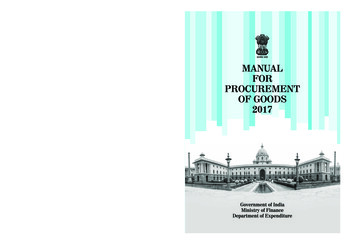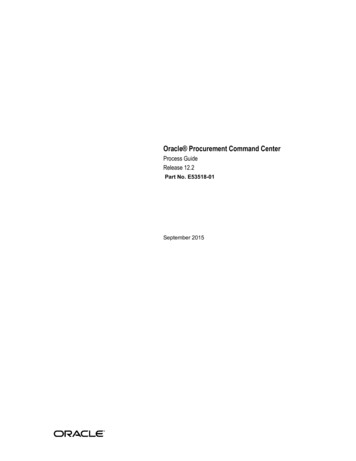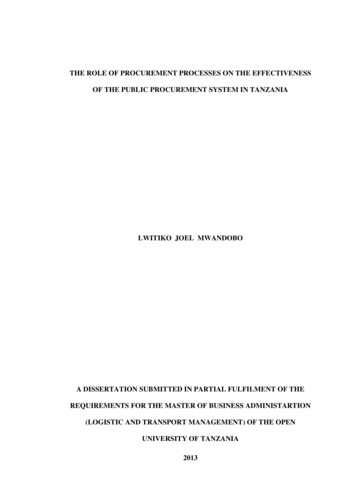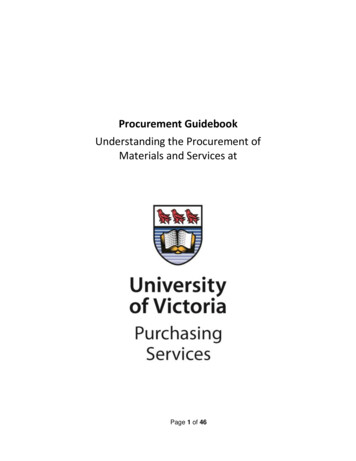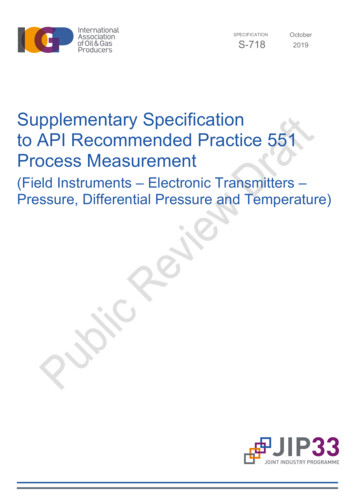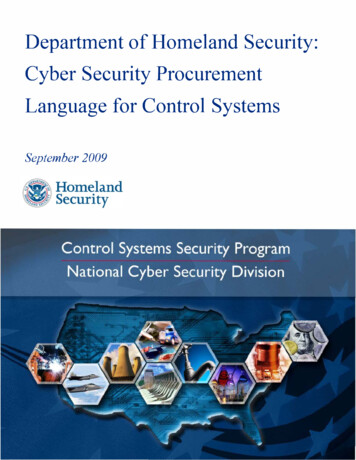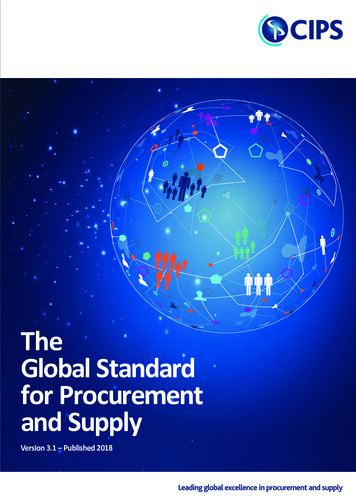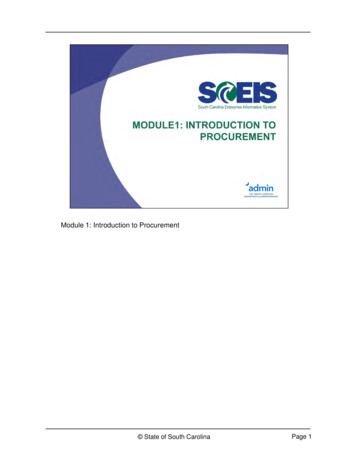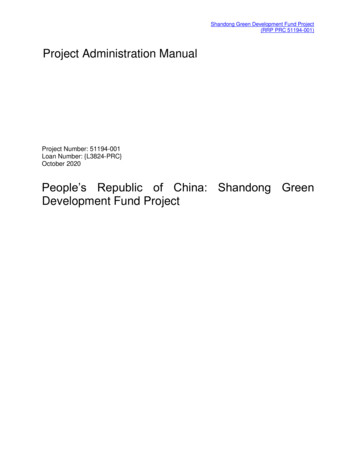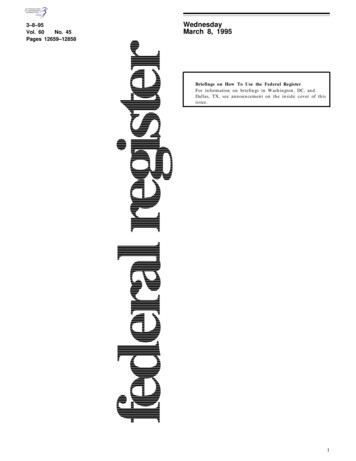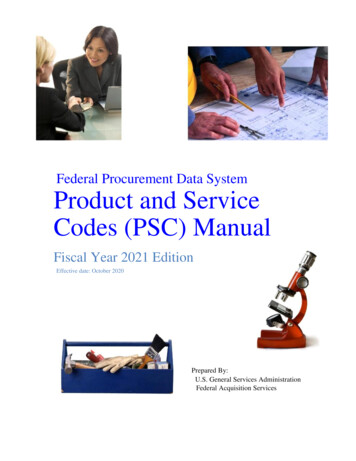
Transcription
Federal Procurement Data SystemProduct and ServiceCodes (PSC) ManualFiscal Year 2021 EditionEffective date: October 2020Prepared By:U.S. General Services AdministrationFederal Acquisition Services
Revision ChartVersionDescription of VersionJIRA Reference#EffectiveDateApproved ByV1.1FY 2010 Passback. Updates based on Team andBlog inputs.N/A1 Oct 11V1.2Update product codes based on DLA FederalService Class (FSC) list changesN/A1 October2015DLA C/F NO 231 dated 13 Feb 2012C/F No 232 dated 23 April 2012C/F NO 233 dated 23 April 2012C/F NO 234 dated 26 August 2013C/F NO 235 dated 4 February 2014V1.2 Activated New Medical ServicesCodes, Category QNA1 October2015IAE CCBV1.2 Updated service code W070-Lease orRental of EquipmentNA1 October2015IAEV1.3 End-dated Product Service Codes(PSCs) D305 IT and Telecom –Teleprocessing, Timeshare, and CloudComputing on 5/19/2019.Activated two new service codes, PSCR616 Support – Administrative:Physical Records ManagementServices and R617 Support –Administrative: Electronic RecordsManagement Services on 5/20/2019.Activated 11 new PSCs--10 new PSCsfor Ship Husbanding Services, and onenew PSC for Aseptic HousekeepingServices—on March 17, 2020.End-dated 721 Research andDevelopment (R&D) PSCs.End-dated 68 IT PSCs.End-dated PSC 6830, which wasrevised.End-dated PSC Q901 AsepticHousekeeping Services, which wasrenamed.Activated 155 new R&D PSCs.Activated 40 new IT PSCs.Activated PSC 6835 (new) and PSC6830 (revised).Activated PSC Q901 HealthcareEnvironmental Cleaning.IAESAM-62620 May2019PCEIAESAM-70917 March2020PCEIAESAM-77930 October2020PCE V1.4 V1.5 3
Organization of This ManualThis manual is organized as follows:Introductory elines/PolicyEnvironmental Reporting RequirementsReporting of Environmental Attributes in FPDSChanges Included in this PSC Manual UpdateA. Summary of Changes to PSC CodesB. Notes on Changes in the R&D CodesC. Notes on Changes in the Service CodesD. Notes on Changes in the Product CodesReportsChange Control ProceduresFrequently Asked QuestionsProduct and Service CodesA. R&D CodesB. Service CodesC. Product CodesAppendices1.2.3.4.5.6.7.Appendix 1 – R&D PSCsAppendix 2 – IT PSCsAppendix 3 – Services PSCsAppendix 4 – Product PSCsAppendix 5 – PSCs with Name ChangesAppendix 6 – PSCs RenumberedAppendix 7 – PSC Crosswalk from Previous Version of Manual4
I.IntroductionThe Product and Service Codes (PSC) Manual provides codes to describe products, services, and research anddevelopment (R&D) purchased by the federal government. These codes indicate “WHAT” was bought for eachcontract action reported in the Federal Procurement Data System (FPDS).The PSC Manual has been updated to reflect the changes made to the PSC codes via FPDS V1.5 Service Pack 4. Inaddition, text regarding the PSC Management Process (p. 4) and Category Management (p. 8) were added to themanual.For more information on the PSC Management Process and the roles and responsibilities of managing the PSC,please reference the PSC Standard Operating Procedures at www.acquisition.gov/PSC Manual.II.Guidelines/PolicyPlease reference the link https://www.acquisition.gov/PSC Manual to obtain the following: Product Service Codes (PSCs) Management Standard Operating Procedures (SOP) which documents theprocess for the administration and management of the Product Service Codes (PSCs);Spreadsheet detailing the Governmentwide Category Management alignment of the PSC; andSpreadsheet with the PSC data codes’ activation and end dates.Two FPDS data elements are the primary focus of the changes in this manual. The PSC is entered in FPDS in dataelement 8A, “Product or Service Code.” Environmental attributes are entered in data element 8L, “RecoveredMaterials/Environmental Attributes.”These product/service codes are used to record the products and services being purchased by the FederalGovernment. In many cases, a given contract/task order/purchase order will include more than one product and/orservice. In such cases, the “Product or Service Code” data element code should be selected based on thepredominant product or service that is being purchased. For example, a contract for 1000 of lumber and 500 ofpipe would be coded under 5510, “Lumber & Related Wood Materials.”Similarly, a given contract/task order/purchase order may include products/services with and without environmentalattributes. In such cases, data element 8L, “Recovered Materials/Environmental Attributes,” should be filled inbased on the predominant product or service that is being purchased. For example, a contract for 1000 of energystar refrigerators and 500 of standard refrigerators would be coded under 4110, “Refrigeration Equipment” with the“Recovered Materials/Environmental Attributes” data element 8L selected as “energy efficient.”Determining the environmental attributes associated with acquisition of services presents challenges. Many serviceacquisitions tend to be predominantly labor-based, which in itself does not have environmental attributes. However,in accomplishing the objectives of the services contract, environmental attributes may apply and it is important toprovide agencies both the flexibility and information to make such decisions. GSA will update this manual withadditional guidance as soon as it becomes available.III.Environmental Reporting RequirementsStatutory requirements and Executive Order 13514 direct the Office of Management and Budget (OMB) Office ofFederal Procurement Policy (OFPP) to report on procurement of products and services with environmental attributesincluding recycled content, biobased, and energy efficient.FPDS will be used to collect data on the procurement of products and services with these environmentalattributes. The initial phase of implementation allows for the collection of the three attributes listed above plus an1
“environmentally preferable” attribute which includes other attributes. The following definitions apply to datacollected in FPDS.ENERGY EFFICIENTPer FAR 2.101, “Energy efficient-product” means a product that—oMeets Department of Energy and Environmental Protection Agency criteria for use of the EnergyStar trademark label; oroIs in the upper 25 percent of efficiency for all similar products as designated by the Department ofEnergy’s Federal Energy Management Program (FEMP).As used in this definition, the term “product” does not include any energy-consuming product or system designed orprocured for combat or combat-related missions (42 U.S.C. 8259b).Per FAR 2.101, “Energy-efficient standby power devices” means products that useoExternal standby power devices, or that contain an internal standby power function; andoNo more than one watt of electricity in their standby power consuming mode or meetrecommended low standby levels as designated by the Department of Energy Federal EnergyManagement Program.BIOBASEDPer FAR 2.101, “biobased product” means a product determined by the U.S. Department of Agriculture to be acommercial or industrial product (other than food or feed) that is composed, in whole or in significant part, ofbiological products, including renewable domestic agricultural materials (including plant, animal, and marinematerials) or forestry materials.ENVIRONMENTALLY PREFERABLEPer FAR 2.101, “environmentally preferable” means products or services that have a lesser or reduced effect onhuman health and the environment when compared with competing products or services that serve the same purpose.This comparison may consider raw materials acquisition, production, manufacturing, packaging, distribution, reuse,operation, maintenance, or disposal of the product or service.For the Product Services Code Manual, this includes categories such as EPEAT registered, water efficient,Significant New Alternatives Program (SNAP)/non-ozone depleting, recovered content, and environmentallypreferable products/services (EPA designated).For the Product Services Code Manual, environmentally preferable also includes building-related or facilitiesrelated services which are associated with “green” industry standards and certifications, such as the US GreenBuilding Council’s (USGBC) Leadership in Energy and Environmental Design (LEED) certification.Environmentally preferable excludes products or services that are predominately bio-based or energy-efficient asthese two categories are defined in the Products and Services Code Manual.2
IV.Reporting of Environmental Attributes in FPDSThe tracking of environmental purchases is going to be accomplished through data element 8L, the “RecoveredMaterials/Environmental Attributes” data element in FPDS. The “Recovered Materials/Environmental Attributes”data element is an existing field in FPDS which has been modified to allow expanded environmental reporting. Thefield now includes a dropdown box with the following options: RCRA FAR 52.223-4RCRA FAR 52.223-4 and 52.223-9No clauses included and no environmental includedEnergy efficientBiobasedEnvironmentally preferableRCRA FAR 52.223-4 and energy efficientRCRA FAR 52.223-4 and biobasedRCRA FAR 52.223-4 and environmentally preferableRCRA FAR 52.223-4 and biobased & energy efficientRCRA FAR 52.223-4 and biobased & environmentally preferableRCRA FAR 52.223-4 and biobased & energy efficient & environmentally preferableThere will not be a validation rule associated with this data element. It will be possible to select an environmentalattribute that does not apply to the given product or service. For example, one could designate PSC 7350 Tablewareas “Energy Efficient.” Therefore, please use caution and select the appropriate field based upon the contractrequirements.V.Changes Included in this PSC Manual UpdateThis section describes the changes that were incorporated in this PSC Manual update. A summary table and detailedcomments for each type of code are provided.A.Summary of Changes to PSC Codes outline in this version of the PSC ManualType of ChangeR&D CodesService CodesProduct CodesEnvironmentalReportingVia data element ��Via data element ��Via data element ��Overall CodeStructureNo change. Still a 4position code.No change. Still a 4-positioncode.No change. Still a 4position code.Multi-Use CodeStructureNo change.Multi-Use CodeReference TablesEliminated reference tablesof multi-use codes for R&Dstages. Complete list of 4digit codes is provided inthe manual.Multi-use facility codeschanged from 3 digits to 2characters.Eliminated reference tables ofmulti-use codes for productbased and facility-basedcodes. Complete list of 4digit codes is provided in themanual.No change.Not applicable3
Abbreviationsand FormattingStandardizedStandardizedConformed to FSCTerminologyAlign Research andDevelopment (R&D) PSCs(codes) to OMB BudgetFunction.UpdatedConformed to FSCClarificationChanged the code title,notes, includes, and/orexcludes fields as needed.Changed the code title, notes,includes, and/or excludesfields as needed.Conformed to FSCCodesRenumberedNoneNoneNone- End-dated 40 IT servicePSCs (codes) which are beingreplaced by new codes.- End-dated PSC 6830which is being revised.Codes End-dated(October 29,2020)- End-dated 721 R&D PSCs(codes) being replaced bynew codes.- End-dated PSC Q901Aseptic Housekeeping, whichwas renamed- End-dated 30 IT productPSCs (codes) which arebeing replaced by newcodes.- Activated 23 new IT servicePSCs (codes).Codes Added(October 30,Month 2020)- Activated 155 new R&DPSCs (codes).- Activate PSC Q901Healthcare EnvironmentalCleaning.- Activated new PSC 6835and revise PSC 6830.Activated 17 new ITproduct PSCs (codes).B. General Comments1.2.3.4.5.Code Structure: The PSCs will continue to be 4-position codes, with products having a digit in thefirst position and services and R&D having a character in the first position. The only significantchange to the content of the codes involves the multi-use facility codes. They have been changedfrom 3 digits to 2 characters to make more efficient use of the available positions.Product Codes: For more information on the PSC Management Process and the roles andresponsibilities of managing the PSC, please reference the PSC Standard Operating Procedures atwww.acquisition.gov/PSC Manual.Abbreviations and Formatting. Abbreviations were made consistent. Where code names includedthe hierarchy, the delimiters between levels were made to be consistent (e.g., the dash and colon in“Architect and Engineering Services- Construction: Office Buildings”).Terminology. The terminology used in the service code names was updated to use modern terms.For example, “Automated Data Processing” (ADP) was updated to “Information Technology”(IT).PSC Category Management Alignment: Governmentwide Category Management optimizedcategory taxonomy for the 10 "Common Spend" categories has been developed,researched, analyzed, and negotiated through the Category Management team, and OMB/OFPPapproved the application to Governmentwide Category Management (GWCM). The GWCM4
category taxonomy should be applied when calculating fulfillment of FPDS-NG based targets forthe Presidents' Management Agenda. Please refer to the Government-Wide Category ManagementTaxonomy for application to the Government-Wide Category Management -rebaseline.C. Research and Development Code Summary1.2.3.4.See “Section A – Research and Development Codes” below for the new definitions for the stagesattributed to R&D codes.One Hundred Fifty-Five (155) Product Service Codes (PSCs) were added. These new R&D codeshave a scheme aligned to OMB Budget Function, and will be activated October 30, 2020.Seven Hundred twenty-One (721) R&D PSCs are being end-dated on October 29, 2020 by newR&D codes starting with “A”.R&D services may or may not have environmental attributes.D. Services Code Summary1.2.End-dated PSC Q901 Aseptic Housekeeping Services, which was renamed to PSC Q901Healthcare Environmental Cleaning.Activated 23 new IT service PSCs (codes) and 17 new IT product PSCs (codes). These new ITcodes have a new schema. End-dated 40 IT service PSCs (codes) and 30 IT product PSCs (codes),which are being replaced by new codes. The new schema for the IT PSCs supports OMB CircularA-11 Section 55 IT Investments by creating a methodology that allows agencies to capture andreport more granular cost data, in alignment with the IT Capital Planning Guidance document asspecified with the A-11.As mentioned above, it can be difficult to determine whether a service has environmental attributes. GSA willupdate this manual with additional guidance as soon as it becomes available. The reference tables of multi-usecodes for product-based and facility-based codes have been eliminated. Instead, the complete list of 4-digit codes isprovided in the manual.E. Product Code Summary1.2.VI.One PSC was end-dated--PSC 6830 which was revised.Two PCSs were activated-- new PSC 6835 and revised PSC 6830.ReportsAd hoc reports may be created for any FPDS data. The Ad Hoc Reports Manual is available athttps://www.fpds.gov. The Ad Hoc Reports Manual is listed under the Training Tab on the site.The ezSearch tool provides the ability to search for contracts based on free text. All contracts searched are in Finalstatus. Any DoD contract that is less than 90 days old will not be included in the search. For specific directions onthe use of ezSearch, see the help material at the following link: https://www.fpds.gov/help/index.jsp.VII.Change Control Procedures for Product and Service CodesPlease reference the Product Service Codes (PSCs) Management Standard Operating Procedures (SOP) athttps://www.acquisition.gov/PSC Manual to obtain the information on the administration and management of theProduct Service Codes (PSCs) to ensure the accurate reporting of Federal spending data related to procurements. Ifyou have any questions on the PSC change management process, please email PSC-Codes@gsa.gov.VIII.Frequently Asked Questions5
What changed?The PSC Manual has been updated as of to reflect the following changes:1.2.3.4.5.6.7. End-dated Seven Hundred twenty-One (721). PSCs that start with “A” are being end-datedon October 29, 2020. These existing R&D codes are being replaced by new R&D PSCs thatstart with “A”.End-dated PSC 6830, which was revised, on October 29, 2020.End-dated 40 IT service PSCs (codes) and 30 IT product PSCs (codes), which are beingreplaced by new codes.Activated 155 Product Service Codes (PSCs). These new R&D codes that start with “A”will be activated on October 30, 2020.Activated 23 new IT service PSCs (codes) and 17 new IT product PSCs (codes).Activated new PSC 6835 and revised PSC 6830 which both activate on October 30, 2020.No other PSCs changes were made.How do I select product/service codes?For a given contract action, the product or service code should be selected based on thepredominant product or service that is being purchased. Why is it important to collect codes accurately?These codes are used to gather data that forms the basis of legally-mandated reports. Policy andacquisition decisions made by Government and private sector executives may be informed by thedata captured in and reported from FPDS. Why are we collecting environmental attributes?The purchase of certain environmentally friendly products and services must be reported perstatute and executive order. The central collection of certain data through FPDS will minimizereporting burden on agencies. How do I determine if a service has environmental attributesDetermining the environmental attributes associated with acquisition of services presentschallenges. Many service acquisitions tend to be predominantly labor-based, which in itself doesnot have environmental attributes. However, in accomplishing the objectives of the servicescontract, environmental attributes may apply and it is important to provide agencies both theflexibility and information to make such decisions. GSA will update this manual with additionalguidance as soon as it becomes available. How are environmental attributes captured in FPDS?Environmental attributes are entered in data element 8L, “Recovered Materials/EnvironmentalAttributes.” The element can capture various combinations of RCRA, energy efficient, biobased,and environmentally preferable attributes.6
Section AResearch and Development Codes7
Research and Development If the contract action is for research and experimental development (R&D) services, report an R&D code.The Office of Management and Budget defines R&D as (see Circular A-11, Section 84, Schedule C):o Research and experimental development activities are defined as creative and systematic workundertaken in order to increase the stock of knowledge —including knowledge of people, culture,and society—and to devise new applications using available knowledge.o R&D must have each of 5 characteristics: novel; creative; uncertain; systematic; and transferableand/or reproducible.Do not assign an R&D code to products purchased in support of research and development work; suchproducts shall be coded using the appropriate PSC product code.The R&D code is composed of two alphabetic and two numeric digits. The first digit is always the letter"A" to identify R&D, the second digit is alphabetic "A to Z" to identify the major area, the third digit isnumeric 1 to 6 to identify a sub-area within a major area, and the fourth digit is numeric 1 to 5, to identifythe appropriate stage of R&D shown below.Codes for Stages of R&D (4th Position)—Code Meaning(1) Basic Research(2) Applied Research(3) Experimental Development(4) Administrative Expenses for R&D(5) Expenses for R&D Facilities and Major EquipmentProcurement personnel responsible for R&D actions shall obtain sufficient information from requisitioningpersonnel to permit accurate classification. When completing this item, the precise R&D Service being purchasedshall be coded.Example: A contract for research on air pollution by aircraft shall be shown under “Natural Resources andEnvironment (AH4*)” for “Pollution control and abatement,” and not under Aerospace Research.Definitions of stages of R&D1.2.3.Basic research. Experimental or theoretical work undertaken primarily to acquire new knowledge of theunderlying foundations of phenomena and observable facts. Basic research may include activities withbroad or general applications in mind, such as the study of how plant genomes change, but should excluderesearch directed towards a specific application or requirement, such as the optimization of the genome of aspecific crop species.Applied research. Original investigation undertaken in order to acquire knowledge. Applied research is,however, directed primarily towards a specific practical aim or objective.Experimental development. Creative and systematic work, drawing on knowledge gained from researchand practical experience, which is directed at producing new products or processes or improving existingproducts or processes. Like research, experimental development will result in gaining additionalknowledge.For reporting experimental development activities include the following: The production of materials, devices, and systems or methods, including the design, construction andtesting of experimental prototypes. Technology demonstration, in cases where a system of components is being demonstrated at scale forthe first time, and it is realistic to expect additional refinements to the design (feedback R&D)following the demonstration. However, not all activities that are defined as “technologydemonstrations” are R&D.8
Exclude: 4.5.User demonstrations where the costs and benefits of a system are being validated for a specific usecase. This includes low-rate initial production activities.Pre-production development, which is defined as non-experimental work on a product or system beforeit goes into full production, including activities such as tooling, and development of productionfacilities. For example, exclude activities and programs that are categorized as “Operational SystemsDevelopment” in the Department of Defense’s budget activity structure. Activities and programs ofthis type should generally be reported as investments in other major equipment.Administrative expenses for R&D. Expenses for R&D, such as the operating costs of research facilitiesand equipment and other overhead costs.Expenses for R&D Facilities and Major Equipment: Expenses for the purchase, construction,manufacture, rehabilitation, or major improvement of physical assets that are necessary for the execution ofan R&D program. Expenses for major moveable R&D equipment include acquisition, design, or productionof major movable equipment for use in R&D activities.Obligations for R&D facilities and major equipment are treated as a stage of R&D. For reporting R&D Facilities andMajor Equipment, include the following: Construction of facilities that are necessary for the execution of an R&D program. This mayinclude land, major fixed equipment, and supporting infrastructure such as a sewer line, or housingat a remote location. Many laboratory buildings will include a mixture of R&D facilities and officespace. The fraction of the building directly related to the conduct of R&D may be calculated as apercentage of the building’s total square footage.Acquisition, design, or production of major movable equipment, such as mass spectrometers,research vessels, DNA sequencers, and other movable major instruments for use in R&Dactivities. Programs of 1 million or more that are devoted to the purchase or construction of R&Dmajor equipment (see OMB Circular A-11, Section 84.3(a)).Exclude: Construction of other facilities, such as office spaceMinor Equipment purchases, such as personal computers, standard microscopes, and simple spectrometers.This should be reported using a product PSC code.9
R&D Services Major AreasCategory AA – Agriculture R&D Services . . . 11Category AB – Community and Regional Development R&D Services . 11Category AC – National Defense R&D Services . 11Category AF – Education, Training, Employment, and Social Services R&D Services . 12Category AG – Energy R&D Services . 12Category AH – Natural Resources and Environment R&D Services . . 13Category AJ – General Science and Technology R&D Services . 14Category AK – Commerce and Housing Credit R&D Services . . 14Category AL – Income Security R&D Services . 14Category AM – International Affairs R&D Services . . 15Category AN – Health R&D Services . 15Category AR – Space R&D Services . . 16Category AS – Transportation R&D Services . . 1610
AA – Agriculture R&D ServicesPSC CodePSC DescriptionAA11Agriculture R&D Services; Agricultural research and services; Basic ResearchAA12Agriculture R&D Services; Agricultural research and services; Applied ResearchAA13Agriculture R&D Services; Agricultural research and services; Experimental DevelopmentAA14Agriculture R&D Services; Agricultural research and services; R&D Administrative ExpensesAA15Agriculture R&D SVCS; Agricultural Research & SVCS; R&D Facilities & MAJ EQUIPAB – Community and Regional Development R&D ServicesPSC CodePSC DescriptionAB11Community and Regional Development R&D Services; Community development; Basic ResearchAB12Community and Regional Development R&D Services; Community development; AppliedResearchCommunity and Regional Development R&D Services; Community development; ExperimentalDevelopmentCommunity and Regional Development R&D Services; Community development; R&DAdministrative ExpensesCommunity and Regional Development R&D SVCS; Community development; R&D Facilities &MAJ EQUIPCommunity and Regional Development R&D Services; Area and regional development; BasicResearchCommunity and Regional Development R&D Services; Area and regional development; AppliedResearchCommunity and Regional Development R&D SVCS; Area & regional development; ExperimentalDevelopmentCommunity and Regional Development R&D SVCS;Area and regional development; R&DAdministrative ExpensesCommunity and Regional Development R&D SVCS; Area and regional development; R&DFacilities & MAJ EQUIPAB13AB14AB15AB21AB22AB23AB24AB25AC – National Defense R&D ServicesPSC CodePSC DescriptionAC11National Defense R&D Services; Department of Defense - Military; Basic ResearchAC12National Defense R&D Services; Department of Defense - Military; Applied ResearchAC13National Defense R&D Services; Department of Defense - Military; Experimental DevelopmentAC14AC15National Defense R&D Services; Department of Defense - Military; R&D AdministrativeExpensesNational Defense R&D SVCS; Department of Defense - Military; R&D Facilities & Maj EquipAC21National Defense R&D Services; Atomic energy defense activities; Basic ResearchAC22National Defense R&D Services; Atomic energy defense activities; Applied ResearchAC23National Defense R&D Services; Atomic energy defense activities; Experimental DevelopmentAC24National Defense R&D Services; Atomic energy defense activities; R&D Administrative Expenses11
AC25National Defense R&D SVCS; Atomic energy defense activities; R&D Facilities and Maj EquipAC31National Defense R&D Services; Defense-related activities; Basic ResearchAC32National Defense R&D Services; Defense-related activities; Applied ResearchAC33National Defense R&D Services; Defense-related activities; Experimental DevelopmentAC34National Defense R&D Services; Defense-related activities; R&D Administrative ExpensesAC35National Defense R&D SVCS; Defense-related activities; R&D Facilities and Maj EquipAF – Education, Training, Employment, and Social Services R&D ServicesPSC 32AF33AF34AF35PSC DescriptionEducation, Training, Employment, & Social SVCS R&D SVCS; Education SVCS R&D; BasicResearchEducation, Training, Employment, & Social SVCS R&D SVCS; Education SVCS R&D; AppliedResearchEducation, Training, Employment, & Social SVCS R&D SVCS; Educ SVCS R&D; ExperimentalDevelopmentEducation, Training, Employment, & Social SVCS R&D SVCS; Educ SVCS R&D; R&DAdministrative ExpensesEducation, Training, Employment, & Social SVCS R&D SVCS; Educ SVCS R&D; R&D Facilities& Maj EquipEducation, Training, Employment, & Social SVCS R&D SVCS; Training & Labor R&D; BasicResearchEducation, Training, Employment, & Social SVCS R&D SVCS; Training & Labor R&D; AppliedResearchEducation, Training, Employment, & Social SVCS R&D; Training & Labor R&D; ExperimentalDevelopmentEducation, Training, Employment, & Social SVCS R&D SVCS; Training & Labor R&D; R&DAdmin ExpensesEducation, Training, Employment & Social SVCS R&D; Training & Labor R&D; R&D Facilities& Maj EquipEducation, Training, Employment, & Social SVCS R&D SVCS; Social SVCS R&D; BasicResearchEducation, Training, Employment, & Social SVCS R&D SVCS; Social SVCS R&D; AppliedResearchEducation, Training, Employment, & Social SVCS R&D SVCS; Social SVCS R&D; ExperimentalDevelopmentEducation, Training, Employment & Social SVCS R&D SVCS; Social SVCS R&D; R&DAdministrative ExpensesEducation, Training, Employment & Social SVCS R&D SVCS; Social SVCS R&D; R&D Facilities& Maj EquipAG – Energy R&D ServicesPSC CodePSC DescriptionAG11Energy R&D Services; Energy Supply; Basic ResearchAG12Energy R&D Services; Energy Supply; Applied ResearchAG13Energy R&D Services; Energy Supply; Experimental DevelopmentAG14Energy R&D Services; Energy Supply; R&D Administrative ExpensesAG15Energy R&D Services; Energy Supply; Expenses for R&D Facilities and Major Equipment12
AG21Energy R&D Services; Energy Conservation; Basic ResearchAG22Energy R&D Services; Energy
V. Changes Included in this PSC Manual Update This section describes the changes that were incorporated in this PSC Manual update. A summary table and detailed comments for each type of code are provided. A. Summary of Changes to PSC Codes outline in this version of the PSC Manual Type of Change R&D Codes Service Codes Product Codes

